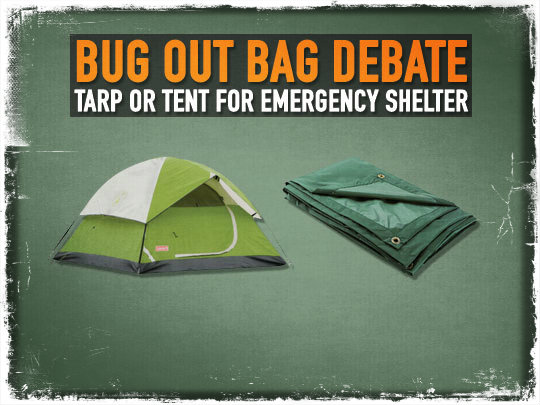
Bug Out Bag Debate: Tarp or Tent for Emergency Shelter
A Bug-Out-Bag Is Designed For Emergencies, So Some Inconvenience Is To Be Expected
When on a family outing, you can carry a six or eight person cabin tent in the back of your vehicle. Weight is not a large factor when you can pack your supplies in the cargo space of an SUV or pickup.
When packing supplies on your back however, weight can be a deciding factor. What you think you can carry on your back, and what you can actually carry, are two different things. Twenty minutes hiking up and down the sidewalk with 30 to 50 pounds strapped on does not mean you can perform the same way physically while in a crisis when walking over rough and uneven terrain for hours at a time.
Tents
Most backpacking tents are designed for 1 to 2 people. A one person tent allows approximately 15 square feet of sleeping space. Keep in mind you will have gear as well, so it will be cramped. The weight can be anywhere from 3 to 6 pounds depending on the model and actual size.
Typically, the tents can be rolled tight and strapped to the outside of the pack, or even put inside if you prefer. The bulky nature is always a problem with tents especially after they have been removed from the retail packaging and set up. They rarely roll up as tight and as compact as they were before removing from the packaging.
Pros
- Better protection from the elements, wind, rain and snow
- Provides good protection from insects
- Easy set up generally, because today’s tents have integrated support systems, so it is just a matter of telescoping the support poles in most cases
- Tents usually do not require other materials for set up other than a tool to pound in stakes
- Provides some ground protection against wet/dampness
Cons
- Expense
- Not as versatile as a tarp, practically speaking a tent has only one function
- Weight
- You could be trapped inside a tent if your camp was overrun
- Reduced fields of vision while inside a tent
Tarps
Tarps come in various sizes, weights, material, colors, and textures. Obviously, you want a tarp that is waterproof, tear resistant and has metal grommets for securing with cordage or stakes.
If you shop around you can find tarps that weigh less than a pound, are waterproof, and have a reflective coating on one side to help protect you from the sun and to help with heat retention in the cold.
If for survival uses you would want a tarp that could also be used for signaling so a brightly colored one would be ideal. On the other hand if you find yourself in a situation where you are forced to use evasion tactics then bright coloring is not ideal.
The weight would allow you to carry more than one tarp. Tarps can be secured together to make a larger shelter, or one can be secured separately over your gear to protect it as well. Tarps can also be used to retrieve larger game kills by fashioning a travois, or simply place the game on the tarp and pull it behind you. You can also use a tarp as an emergency stretcher to carry injured personnel.
Pros
- Lightweight
- Inexpensive
- Has more uses than a tent
Cons
- Requires additional materials such as cordage and poles to make a shelter or to secure over gear
- No ground protection
- Less protection from the elements
- Requires certain skill sets to make an adequate shelter
Ideally, you could carry both. If you are moving fast, and can only take a few hours for rest then a tarp would be ideal. You would have some protection from the elements, because you can literally roll up in one, or drape it over a limb or even a bush to gain some cover.
Tents are ideal however, if you plan to make camp for an extended period, but they may be harder to camouflage if you have to worry about others stumbling upon your camp.
A quality tent would be the best choice in many cases, because of the protection a tent offers from the weather and insects. Carry a good tent and one or two quality lightweight tarps, so as the situation on the ground changes you can adapt.